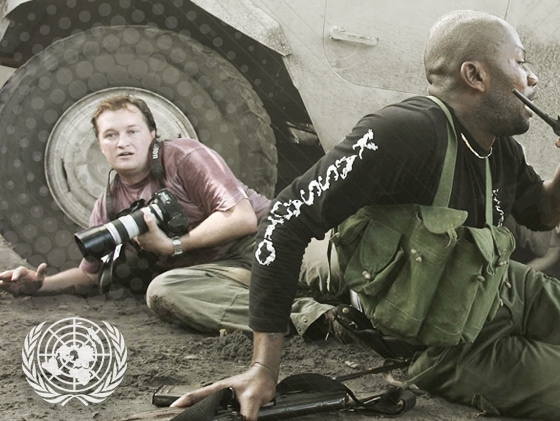The UN Plan of Action is very comprehensive, and definitely worth a close read - but to get you started, we've pulled together five things everyone should know about the plan, as well as snapshots of the climate for media and free expression in four of the countries where the plan will be implemented first: Iraq, Nepal, Pakistan and South Sudan.
When a problem is global, it calls for a global response. The scale and number of attacks on journalists and media workers around the world, combined with failures to investigate and prosecute crimes against them, have each contributed to the unacceptably high level of personal risk that journalists and others continue to face simply for exercising their right to free expression. In response, the United Nations has developed an approach called the UN Plan of Action on the Safety of Journalists and the Issue of Impunity.
The plan is very comprehensive, and definitely worth a close read – but to get you started, we’ve pulled together five things everyone should know about the plan, as well as snapshots of the climate for media and free expression in four of the countries where the plan will be implemented first: Iraq, Nepal, Pakistan and South Sudan.
1. What is the UN Plan of Action on the Safety of Journalists and the Issue of Impunity?
The plan is a set of objectives, principles and actions developed by UNESCO’s member states and endorsed by the UN Chief Executives Board on 12 April 2012, intended to directly address the problem of journalists’ safety and the problem of impunity.
2. What is it supposed to achieve?
The plan is designed to uphold the fundamental right of freedom of expression, which ensures that citizens are well informed and able to actively participate in society. It aims to do this by creating a free and safe environment for journalists and media workers, including social media producers, in two ways: by introducing mechanisms designed to reduce the danger — both in conflict and non-conflict situations — and by strengthening the legal mechanisms available nationally, regionally and globally, that support the right to freedom of expression and information.
3. Who is involved in implementing the plan?
The problem exists at many levels, and so too must the solution. The plan is designed to include all stakeholders. It incorporates roles for governments, non-governmental organisations, academics, the media, and others working at global, regional, national and local levels, and its success will depend on the full participation of all.
4. What are some of the planned actions?
• Raising awareness among citizens about the consequences when journalists have their right to free expression curtailed.
• Helping governments develop laws to safeguard journalists.
• Providing training courses for journalists.
• Establishing real-time emergency response mechanisms.
• Strengthening the safety of journalists in conflict zones.
• Sensitizing member states, journalists, media owners, policy makers, news organizations, editors and journalists on the growing dangers and emerging threats to media professionals and non-state actors.
5. Where will the plan be implemented?
In its initial phase, the plan will be implemented in Iraq, Nepal, Pakistan and South Sudan. Countries in Latin America like Mexico and Honduras are also under consideration.
Sources: Committee to Protect Journalists (CPJ), Freedom Forum, Human Rights Watch, International Media Support (IMS), Journalism Freedom Observatory (JFO) in Iraq, Pakistan Press Foundation (PPF), UNESCO
Act now to ensure the plan is implemented.
The Letter
To: Hon. Pervez Rashid, Minister for Information and Broadcasting in Pakistan
Prime Minister Nouri al-Maliki of Iraq
Prime Minister Khil Raj Regmi of Nepal
Mr. Mustafa Biong Majak Koul, Director General of Information, South Sudan
11 November 2013
Your Excellencies,
As we mark the upcoming International Day to End Impunity on 23 November, we would like to draw your attention to the UN plan to protect journalists and combat impunity and ask you to implement it in your country. In its initial phase, the plan will be implemented in Iraq, Nepal, Pakistan and South Sudan.
The scale and number of attacks on journalists and media workers around the world, combined with failures to investigate and prosecute crimes against them, have each contributed to the unacceptably high level of personal risk that journalists and others continue to face simply for exercising their right to free expression. In response, the United Nations has developed an approach called the UN Plan of Action on the Safety of Journalists and the Issue of Impunity.
The plan is a set of objectives, principles and actions developed by UNESCO’s member states and endorsed by the UN Chief Executives Board on 12 April 2012, intended to directly address the problem of journalists’ safety and the problem of impunity.
The plan is designed to uphold the fundamental right of freedom of expression, which ensures that citizens are well informed and able to actively participate in society. It aims to do this by creating a free and safe environment for journalists and media workers, including social media producers, in two ways: by introducing mechanisms designed to reduce the danger — both in conflict and non-conflict situations — and by strengthening the legal mechanisms available nationally, regionally and globally, that support the right to freedom of expression and information.
The problem exists at many levels, and so too must the solution. The plan is designed to include all stakeholders. It incorporates roles for governments, non-governmental organisations, academics, the media, and others working at global, regional, national and local levels, and its success will depend on the full participation of all.
Please help by implementing the following relevant aspects of the plan:
• Raising awareness among citizens about the consequences when journalists have their right to free expression curtailed.
• Helping governments develop laws to safeguard journalists.
• Providing training courses for journalists.
• Establishing real-time emergency response mechanisms.
• Strengthening the safety of journalists in conflict zones.
• Sensitising member states, journalists, media owners, policy makers, news organisations, editors and journalists on the growing dangers and emerging threats to media professionals and non-state actors.
Thank you for your attention and we look forward to a response.



